10 Takeaways from the state of SEO survey
We explore the top 10 takeaways from the survey data - think of it as a TLDR version of data collection from hundreds and hundreds of interested parties.
We explore the top 10 takeaways from the survey data - think of it as a TLDR version of data collection from hundreds and hundreds of interested parties.
Here at Zazzle Media, we love surveys – we run them every year to help us better understand the challenges facing both SEO Managers and Agencies alike. Each year we look to prune the questions down and build others out as trends and future opportunities dictate (for example in 2018 we asked more questions around mobile-first preparation).
This year we looked to gain insight into more recent smaller topics such as the impact of Medic or the ease of protecting branded search terms.
In this article we explore the top 10 takeaways from the survey data – think of it as a TLDR version of data collection from hundreds and hundreds of interested parties. See some topline stats or explore the full survey results by clicking here and downloading them.
Any digital marketing professional with a few years of experience in the game has likely dabbled in the disciplines below. While certain practices take far more technical expertise (think, IA and CTR Optimisation) it’s reassuring to know that the marketers still find content creation to be the best approach in acquiring traffic and hitting KPIs.
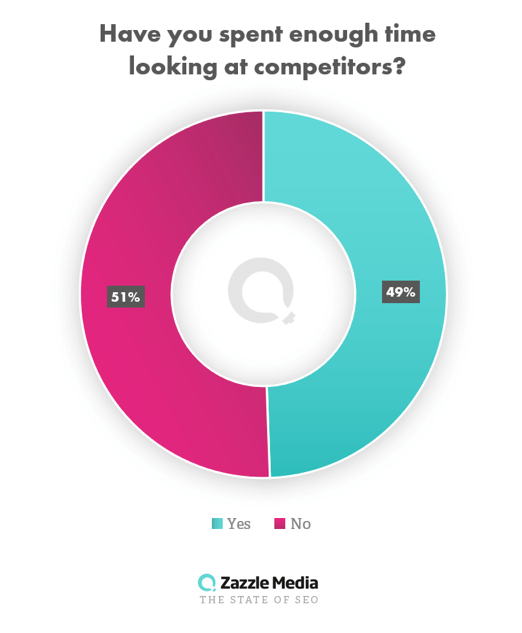
Likewise, it’s easy to focus on moving forward, many content strategies do just that, and that alone. However, auditing existing content and making tweaks or tests where needed is almost as important, that’s why it shows up as the second most voted for discipline.
A few years ago I would have expected the “creation of new content” and “link building” to have utterly dominated this chart. It’s fantastic to see professionals finding more and more value in other avenues with “Brand mentions” and “CTR optimization” gaining a not insignificant seat at the marketing table.
I’ve long advocated a need for SEO professionals to blur at the edges, merging with other teams and marketing/web-development disciplines. This wider and more holistic view of digital marketing is fast-becoming the rule instead of the exception. A big part of this is how news and knowledge sharing sites have diversified and so helped inform both agencies and managers alike.
…and I for one, couldn’t be happier with that! Link building by quantity has always been a bugbear of mine. The demand for the service has created sites that sell links by DA as casually as if they were sweets. These companies are still inexplicably in business despite the wider community knowing full well that many of the sites used have been “blacklisted” by Google. Oh yeah, they do that…
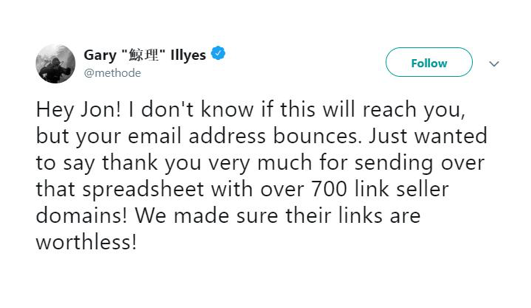 Imagine spending hundreds, maybe even thousands of such links without ever really knowing if they’ve made any kind of impact. It’s no wonder that marketers are more unsure about the value in link building over anything else in an SEO agency’s arsenal.
Imagine spending hundreds, maybe even thousands of such links without ever really knowing if they’ve made any kind of impact. It’s no wonder that marketers are more unsure about the value in link building over anything else in an SEO agency’s arsenal.

As happy as I might be with the headline the lack of confidence in Non-branded PPC vs Technical SEO is somewhat worrying. I’ve dabbled in paid (largely on social) and found that it provided me with exact costs for cost per acquisition, cost per conversion – all the stats I could digest. It’s also concerning that UX is still so much of a mystery, in the next few years I hope my CRO/UX brethren can educate marketers to close this gap. Platforms and CMS’ have never been easier to split test, and while I appreciate truly putting the user’s experience first is something of a rarity in sites, the benefits of doing so are well documented.
It seems like years ago that we were talking about the mobile-first index… probably because it was (https://webmasters.googleblog.com/2016/11/mobile-first-indexing.html). Despite all the time to prepare, it seems Google hasn’t completed the full rollout quite yet, or perhaps have yet to inform webmasters, I’m not sure which would be worse come to think of it.
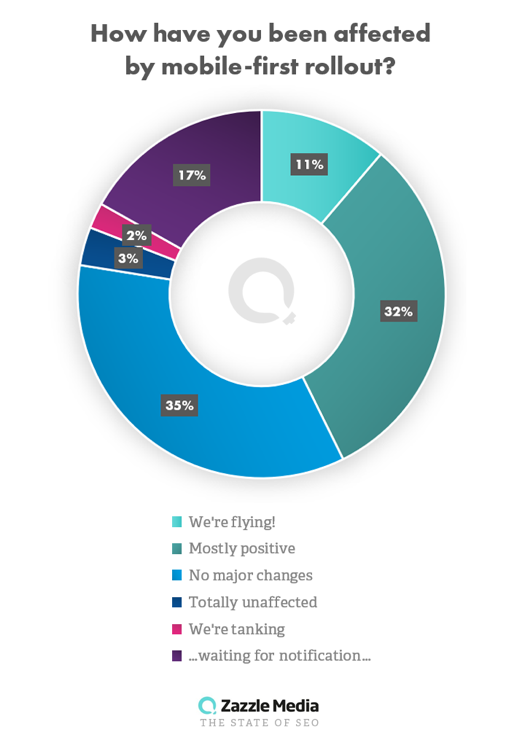
Whether you have a notification or not, there are a slim non-zero number of sites that can afford to ignore mobile users entirely – possibly sites still optimizing for IE6? It’s great to see over 43% have been positively impacted by the shift to mobile-first. For the slim two percent that has been hit hard by the changes, I imagine they’re seeing their market share eaten into, or have dropped due to a legacy CMS that could do with a shakeup. In any case, there are hundreds of articles around that help you optimize for mobile – not least of all, Google themselves (https://search.google.com/test/mobile-friendly).
Each year we run our surveys we find that the implementation of technical fixes gets faster and faster. Whether this is due to development teams taking sprint-led approaches, businesses feeling under pressure to squeeze as much value from their sites as possible or just a growing understanding for the need to have a site that is “technically fit for purpose” we don’t much care – 75% of marketers are getting technical fixes implemented within a month. Get in.

If you’re still having to put together business cases for changing H1s or adding alt text to images – I feel for you son, I’ve got 99 problems but a technical glitch ain’t one. You may want to read this great article from Rory Truesdale on building a business case your boss can’t say no to.
We make a lot of demands from Google, if you’re like me then more often than not is the adherence to its own policies and not rewarding bad practice… or longer battery life on my phone. However, I’ll keep those grudges inside for now.
Interestingly, aside from the standard request that rolls out on these questions (that of more keyword-specific user/click data), there are a significant number of marketers who aren’t clear on all of Google’s guidelines.

I feel much of these are perhaps just managers and executives just not having the resource or time to give Google’s webmasters forum and help center a good readthrough. You can find the basic guidelines here, the article has links to more information content, quality, and snippets too.
It’s clear that the overhaul of the search console is relatively positive (if a little segmented) and I’m sure we all welcome new innovation and insights within WMT/GSC. Something I expect will come soon is the visibility around voice searches – data suggests nearly 50% of searches will be made by voice in the next few years, but right now strategies to capitalize on this are focusing almost exclusively on featured snippets as they are the only thing we can really measure with a modicum of accuracy.
Here’s the catch, Google and users reward content that is unique or content that utilizes the most appropriate format for the message/information. Trouble is, the production of certain formats are costly, the main reason for all the “no” responses was just that – the cost, the second was people finding a reliable artist/animator/SFX professional.
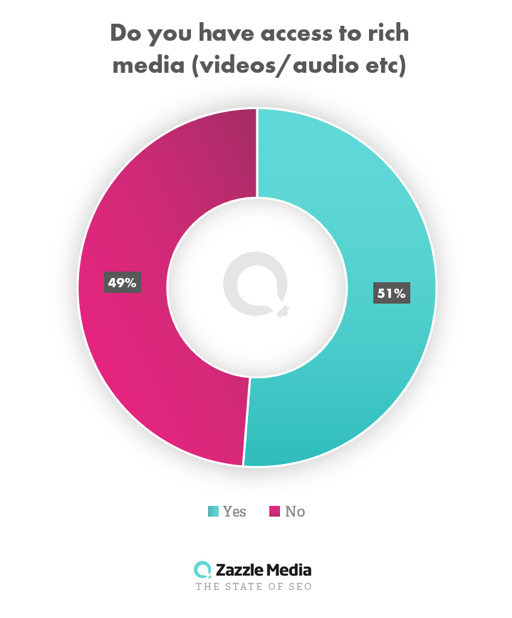
There are a number of sites around where you can find appropriately priced artists that can provide such services but it’s perhaps easier to ask any agencies you work with for their recommendations. After all, we cross paths with a huge number of digital professionals that might suit your needs. For something more affordable and entry-level you can often find amateur or startups willing to work for realistic rates within Facebook or LinkedIn groups.
It’s important to be realistic with your desire for rich media, it takes far longer than you might expect to become truly proficient with many of the tools and software platforms required for a quality result. Don’t be afraid to give it a shot. But make sure you aren’t producing video or podcasts just for the sake of it, if you miss the mark with a blog post you lose a few hours, do that with a video and it’s far harder to explain it away in your next appraisal.
In a recent training session, I ran on Content Strategy at BrightonSEO, this was one of the biggest problems felt by both in-house and agency professionals. The skyscraper approach works best when you are “one-upping” the competition. However, many markets are just seeing content duplication over and over – backed up by basic link building to gain the edge.

My advice to those of you looking for an answer will be the same as those at the training session.
Aside from the habitual checking of Facebook and Instagram stories, what sites are you drawn back to? Can you figure out why they have such an attractive appeal to their content? Is it the tone? Is it imagery? Can you work out what would make your audience feel the same way about your site?
You don’t need a funky brand or hip product to be magnetic, you just need to service the most critical needs of your audience better than your competitors. Do everything right, from UX in the checkout process to follow-up emails and nurture campaigns. It might sound like a big ask and if you’re struggling with the scale of it all, try to do less, but do it better.
This for me is unforgivable. A sailor is nothing if they don’t keep one eye on the waves around them.
It’s critical to innovate and try to lead the way but the chances of you always being at the front of your market are zero. Instead, you need to be mindful of what the competition is doing and utilize third-party tools to monitor them effectively.
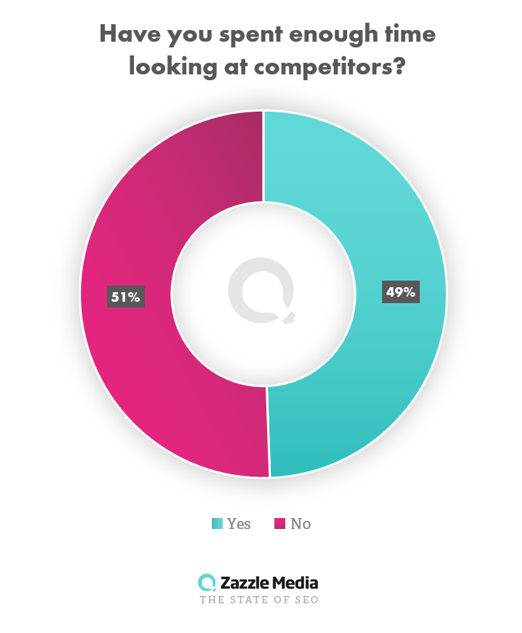
If you’re reading this with a sinking feeling of guilt, it’s not too late. Competitor research is a well-documented discipline in both organic and paid search. The vital point is to learn from both the victories and the mistakes made by the competition. If you spot a campaign that flopped but clearly had significant investment, it’s important you tear it apart and work out how you could have done it better.
If you’re working with an agency and feel that your level of competitor insight isn’t great then consider it as a research project that you can undertake collaboratively in the next quarter. Remember, that you have lots of different types of competition:
These groups aren’t mutually exclusive and you might find two contrasting competitors that crossover due to your position in a market (an averaged priced womenswear brand would crossover with both Primark and ZARA, despite the two having minimal product/price overlap).
There was a time when brands felt confident that with an “about us” page they were relatively well protected in the SERPs, perhaps a few subdomains thrown in for good measure. However, it’s clear that there is no honor among marketers anymore. Bidding on other brand terms has never been more popular. Organically we’ve responded to the clear user demand for “brand vs brand” terms, creating fresh content to target both competitor brand traffic and users in the consideration stage of a purchase journey.

Let’s be honest though, this is just good business sense in most cases. I recommended the production and optimization of a comparison page for RAC to target AA terms and the results generated both traffic and revenue despite the clear user intent for “aa breakdown cover”. The RAC site still ranks in third position for the head term with 600+ other keyword rankings and estimated the traffic of over 10k accordingly to Ahrefs.

Of course, that’s an extreme case, in an industry where there are only 2 ½significant players (sorry GreenFlag) with substantial branded traffic and searches. If you want to find out more about how to protect your brand from this sort of activity, you can check out a tool I created here, to help organize your branded traffic results and make sure they are tip top shape.
Always end on a negative? Our survey suggested that more and more marketers are spending their budget elsewhere, the results felt a little too open-ended so we followed up the question to dig into why they’re spending five percent less on SEO than last year.
Interestingly, 60% of marketers state that resources and a shortage of budget are the main reasons they don’t spend more on organic. However, just over 30% still find proving the value of SEO to be a critical factor in securing funds or resources, further pushing the need for agencies, freelancers and in-house professionals to be aware of attribution models, brand value and purpose when it comes to spending more on SEO.
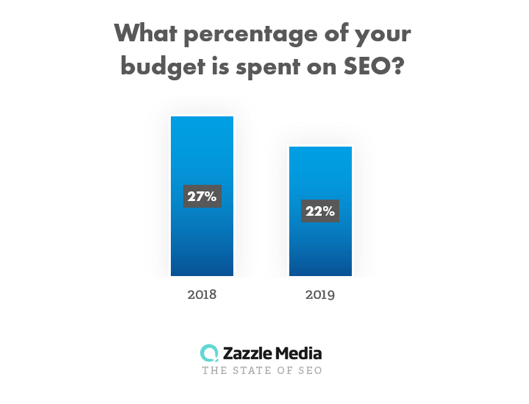
As an industry, we’ve needed to educate, educate, educate – at almost every level of client infrastructure. That challenge still remains, in fact, it probably changes monthly. But now with more noise than ever (think CRO, Social, and EDM).
It doesn’t make you a poor search professional if you’ve struggled to educate your manager, in my experience they can be quite resilient to tutelage.
These are just 10 of what I felt were the most interesting results from a survey containing over 40 digital marketed questions asked hundreds of digital marketing professionals. If you’d like to end your day with a little more insight, the results are all available to download.
Stuart Shaw is Head of Search & Strategy here at Zazzle Media.